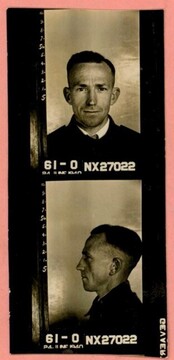
HAWKES, Edgar Charles
| Service Number: | NX27022 |
|---|---|
| Enlisted: | 8 July 1940 |
| Last Rank: | Private |
| Last Unit: | Not yet discovered |
| Born: | Croydon Park, New South Wales, Australia, 7 August 1910 |
| Home Town: | Not yet discovered |
| Schooling: | Not yet discovered |
| Occupation: | Not yet discovered |
| Died: | Died at sea (Rakuyo Maru), South China Sea, 12 September 1944, aged 34 years |
| Cemetery: |
No known grave - "Known Unto God" Labuan Memorial, Labuan, Malaysia |
| Memorials: | Australian War Memorial Roll of Honour, Ballarat Australian Ex-Prisoners of War Memorial |
World War 2 Service
| 3 Sep 1939: | Involvement Private, NX27022 | |
|---|---|---|
| 8 Jul 1940: | Enlisted Australian Military Forces (WW2) , Private, NX27022 |
Help us honour Edgar Charles Hawkes's service by contributing information, stories, and images so that they can be preserved for future generations.
Add my storyBiography contributed by Aubrey Bairstow
Edgar Charles Hawkes was born in 1910 in New South Wales and enlisted at Ashfield in July 1940. He was married and stated that he was a Compositor. He fell ill with renal trouble during training, delaying his embarkation with 2/20th Battalion. During this time his son Barry was born so he was given pre-embarkation leave until late December 1940.
He embarked in February 1941, arriving in Singapore later that month. When Singapore fell he was deemed missing, being recovered as a Prisoner of War in November 1943 and his location Thailand being determined the following month.
Having just been returned to Singapore after surviving the horrors of the Burma Thai Railway he was selected for work in Japan. The Japanese transported prisoners of war great distances across their empire. The worst and most dangerous period in a prisoner’s life was travelling in captivity. Over-crowding, sickness, disease and the dangers posed by Allied submarines caused much stress and anxiety. Conditions on board these ships were severe: over a 1,000 prisoners might be crammed into spaces suitable for a few hundred and given little food, fresh water, or adequate sanitation facilities. Some journeys lasted just a few days, but the longest was a voyage from Singapore to Japan which took 70 days (this was the Rashin Maru, known to prisoners as the “Byoke Maru”, or sick ship). The prisoners of war called these transports “hellships”. Edgar was a passenger on the Rakuyo Maru.
The Rakuyō Maru (with 1,318 Australian and British prisoners of war aboard) and Kachidoki Maru (900 British prisoners of war) were part of a convoy carrying mostly raw materials that left Singapore for Japan on 6 September 1944. The prisoners were all survivors of the Burma-Thailand Railway who had only recently returned to Singapore.
On the morning of 12 September 1944 the convoy was attacked by American submarines in the South China Sea. Rakuyō Maru was sunk by USS Sealion II and Kachidoki Maru by USS Pampanito. Prisoners able to evacuate the ships spent the following days in life rafts or clinging to wreckage in open water. About 150 Australian and British survivors were rescued by American submarines. A further 500 were picked up by Japanese destroyers and continued the journey to Japan. Those not rescued perished at sea.
A total of 1,559 Australian and British prisoners of war were killed in the incident, all missing at sea (1,159 from Rakuyō Maru, 400 from Kachidoki Maru). The total number of Australians killed was 543 (503 AIF, 33 RAN, 7 RAAF).
Edgar Hawkes was one of those who died either at sea or in the hold of Rakuyo Maru.









